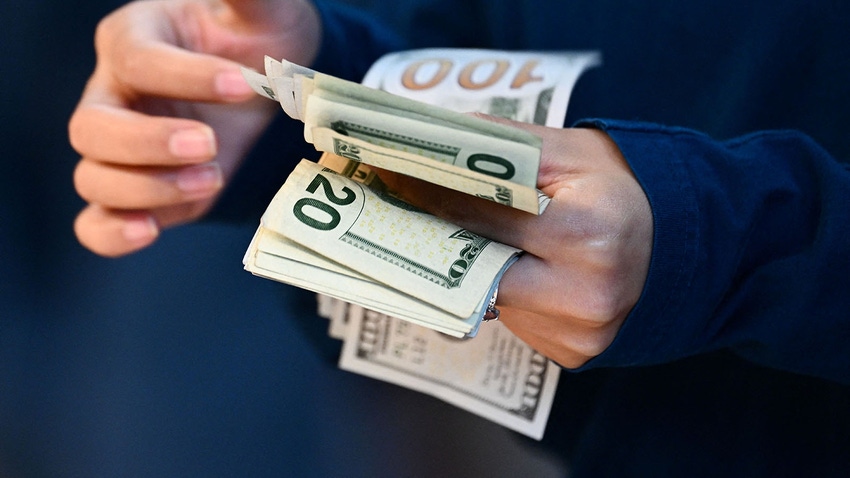Resin Price Report: Challenging Year Ends in Shopping Spree
December saw the highest volume of resin changing hands in almost two years.
January 5, 2024

At a Glance
- Abundance of deeply discounted railcars arrive just in time for Christmas
- Processors took advantage of well-priced resin to restock inventories
- PE resin prices stay flat while PP prices rise another $0.03/lb in December
It was all smiles at the PlasticsExchange as the year came to a close. December was the highest volume month at the resin clearinghouse in almost two years. The spot resin markets remained busy right up until the Christmas break, with an abundance of deeply discounted railcars available during December, polyethylene (PE) more so than polypropylene (PP). Most offers were sold by the end of the third week. Then, the deals dried up, and we skated quietly into year’s end, writes the PlasticsExchange in its Market Update.
Strong buying could impact January demand
Demand was very good the last week of the year, and market sentiment improved significantly. The heaviest buying came from processors who took advantage of well-priced resin to restock inventories with multi-railcar orders, which could impact January demand.
Spot resin prices were mixed in December. PE was flat to a penny lower, pulled down by the heavy flow of discounted prime railcars, while PP prices rose $0.03/lb during the month on the heels of monomer strength and dwindling availability. Spot moved in contrast to contracts, where PE might have finally shed $0.03/lb, but remains unsettled, while PP contracts were mostly steady, bucking initial thoughts of price relief.
Export markets were very busy during December, too. Prices were lowered early to remain competitive globally, and then firmed during the second half of the month as stocks cleared while demand remained, and Asian prices moved higher.
A challenging year
The past year saw a lot of challenges — most resellers’ volumes were down compared to 2022 as de-stocking continued through much of the year and processors exercised caution rebuilding inventories as interest rates rose, which created a significant cost to carry.
While the petrochemical-producing gulf managed to avoid disruptive hurricanes, there were plenty of other supply chain disruptions — refinery fires, propane dehydrogenation (PDH) unit outages, resin reactors taken offline, and logistics complications such as Mexico/United States border issues, Panama Canal limitations, and the still developing war-related disruptions in the Persian Gulf and Mediterranean and Red Seas, which are already affecting freight rates and trade routes, notes the PlasticsExchange.
PE began 2023 with an uptick, as winter storm Elliott in late December 2022 caused damage at Houston area resin facilities, which triggered two force majeure declarations. Resin Price Report readers will recall that producers had reduced reactor rates substantially while ramping up exports to record levels, resulting in tight supplies. The December disruptions were leveraged to implement a $0.03/lb price increase for January contracts. The domestic markets remained relatively slow, although exports continued strong and helped soak up surplus supplies while providing a rising floor to spot pricing. Additional production disruptions sapped supplies and a third and fourth force majeure on HDPE were put in place — CPChem, Ineos, Formosa, and Nova — partly because a tornado hit Houston and an ethylene supply issue affected plants in Canada, according to the PlasticsExchange. Spot PE prices moved $0.04 to 0.06/lb higher for the young year; producers were able to implement another $0.03/lb price increase in March, though many thought it was unwarranted. PE production ramped back up while domestic demand was soft, so inventories soared more than 800 million pounds from March to May, and spot prices began a steady slide of $0.08 to 0.13/lb, depending on grade, that lasted through July. New PE production was brought online from Shell, Nova, and Baystar, and producers acquiesced to a $0.03/lb decrease in June, leaving contracts up $0.03/lb for the year, though spot prices were down a net nickel on average since 2023 began. As the hurricane season got underway, we saw some extra buying from processors building up inventory buffers, writes the PlasticsExchange, but the season proved to be benign, so processors essentially had more resin than they needed.
Banner year for exports
Exports became the name of the game, writes the PlasticsExchange, and a series of records were established, with volumes running well above two billion pounds per month from May until the end of the year. Exports again began to clean up surplus supplies and lift the low end of the spot market, which bottomed out at the end of July. Momentum began to build and a $0.03/lb increase was implemented in both August and September, bringing the net 2023 increase to $.09/lb. The seasonal rally pushed spot prices $0.04 to 0.05/lb higher, until they topped out again in late October as most production issues had been resolved. Somewhat softer prices ensued, spurring better domestic demand and making the fourth quarter the strongest of the year at the PlasticsExchange. Most resellers reported similar results. The market was awash with resin during December, but it cleaned up nicely and began to tick higher again into year-end.
December contracts trending down
December contracts have not officially settled, but they seem to be heading toward a $0.03/lb decrease. If so, contracts will end the year with a net $0.06/lb gain. Spot prices did not fare as well — they were down an average of $0.05/lb during 2023. Producers have been rolling their next nominated increase ever since October and will give it another shot as we begin 2024.
The PP market took a very different course during 2023. It began under heavy pressure in a drawn out bear market since May 2022, which cut its value by more than half. In an effort to stem the slide, PP producers had drastically reduced their operating rates to an average below 70% for four straight months. By January 2023, upstream inventories were at their lowest point in 17 months, according to the PlasticsExchange.Three PDH units supplying feedstock polymer-grade propylene (PGP) monomer went offline just prior to the end of the year, and as the calendar turned to 2023, PGP prices took off. They rallied a nickel to $0.375/lb during the first week of January and accelerated from there. By the end of the month, PGP reached $0.43/lb. PP prices were highly correlated to PGP monomer, and so resin prices also sky-rocketed. Many processors were caught short of material, but overall PP demand was dismal and processors held out with minimal purchases to avoid high-volume buys near peak pricing. PP contracts jumped $0.10/lb in January, but spot resin prices could not keep up and only added 8 cents. Operational issues continued and PGP prices climbed to $0.60/lb by the end of February, essentially doubling in the first two months of the year. PGP and PP contracts added another $0.08/lb in February, while spot resin prices continued to lag, only managing another $0.04/lb gain during the month. Spot PGP prices eventually peaked at $0.73/lb at the beginning of March and fell to $0.60/lb by the end of the month. PGP contracts inked another $0.08/lb gain in March, but PP contracts only added another nickel, yielding some margin erosion. The spot market had already peaked and lost a net $0.04/lb during March. It continued to slide from there. PP producers had come to rely on the on-purpose PGP production from PDH units, which convert cost-advantage propane directly into PGP monomer. While the advent of PDH units eventually will prove to be a fruitful endeavor, there is clearly some fallout along the way, writes the PlasticsExchange.
Read the full Market Update on the PlasticsExchange website.
About the Author(s)
You May Also Like




